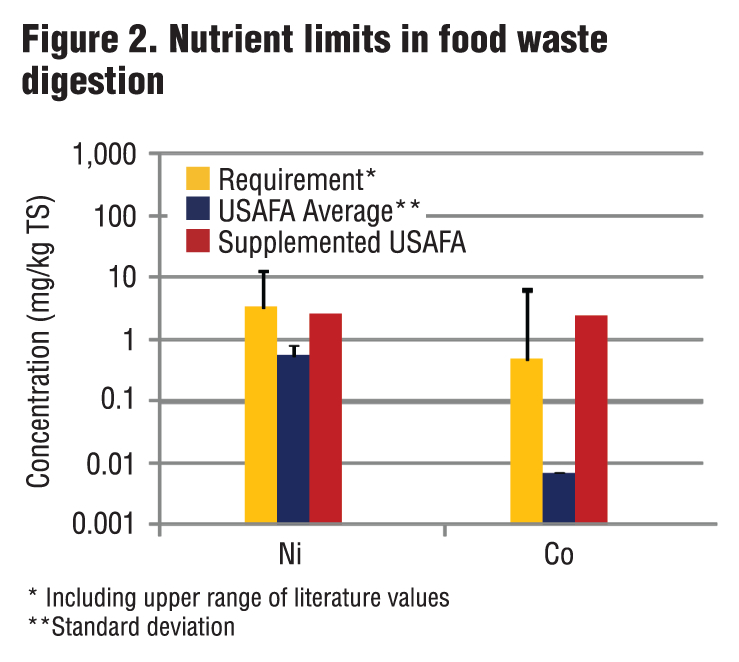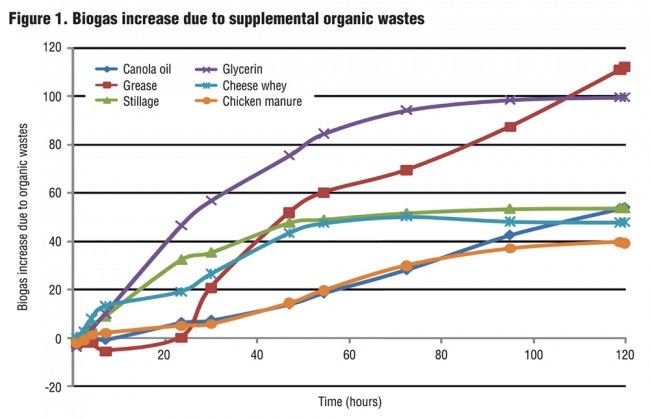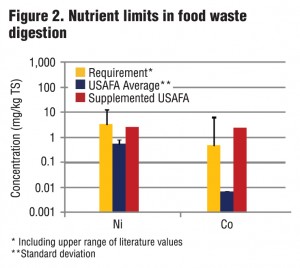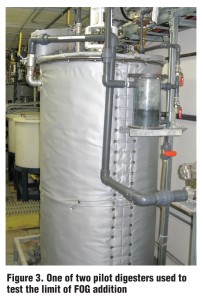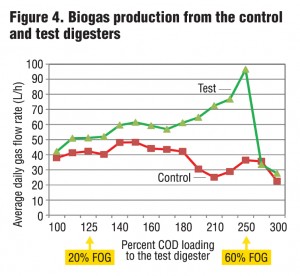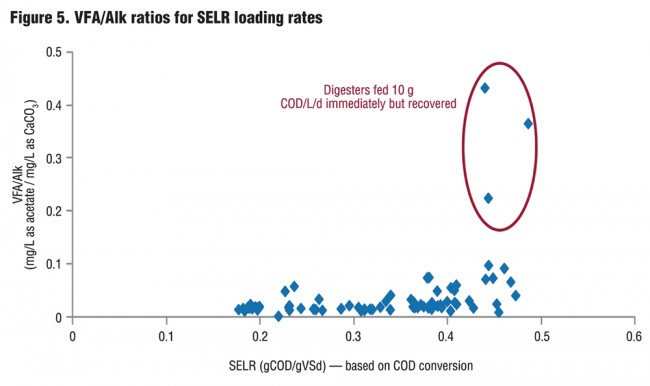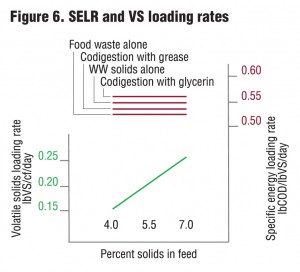Research can improve the economic viability of codigestion facilities and ease concerns of managers of water reclamation facilities about receiving additional organic waste and the potential for digester upsets. Part II
David L. Parry
BioCycle May 2013, Vol. 54, No. 5, p. 32
Water reclamation facilities are taking advantage of codigestion by supplementing wastewater solids fed to digesters with organic waste. Direct benefits to water reclamation plants include increases in biogas production and a tipping fee revenue stream. A significant barrier is concern about the impact on digester operations. Codigestion research can increase operators’ confidence regarding the stability of digestion systems receiving a variety of organic wastes. Research helps develop more sophisticated organic loading rates to enable more aggressive loading while maintaining stability. Higher organic loading rates increase the capacity of existing digesters, and can enable installation of smaller (and thus lower cost) new digesters for a specified capacity. The economic viability of codigestion facilities are improved when more can be gotten out of a given digester volume.
Among the questions that can be answered through codigestion research are: How much biogas will be produced from a given organic waste? What is the maximum organic loading rate? How much fats, oils, and grease (FOG) can be added while maintaining stable digester operation? CDM Smith has conducted research on codigestion with the Water Environment Research Foundation (WERF) and the Environmental Sustainability Transfer Certification Program (ESTCP) to find answers on organic loading rates, digester stability and biogas production that is leading to improved economic viability and operator confidence in codigestion.
For design and operation of codigestion facilities, it is important to know the amount of biogas that will be produced and how much organics can be fed to the digesters. The biochemical methane potential (BMP) and the achievable organic loading rates for codigestion were researched in both the laboratory and at a pilot facility on a WERF codigestion project. Anaerobic digestion of food waste alone was researched on an ESTCP project using leftovers from the cafeteria at the United States Air Force Academy (USAFA). The necessary concentrations of food waste fed to the digester and the nutrients for healthy digestion were determined. The limits for organic loading rates to anaerobic digesters were evaluated in terms of a specific energy loading rate.
Biochemical Methane Potential Tests
Standard methods were used in the laboratory for conducting BMP tests of a variety of organic wastes. The biogas increase due to various organic wastes being added to municipal wastewater sludge is shown in Figure 1.
The amount of organic waste was adjusted in order to feed the same amount of chemical oxygen demand (COD) to each digester. The difference in biogas production reflects the digestibility of the organic waste. Note the initial negative impact on gas production from the addition of grease indicating some initial inhibition to digestion. However, after 120 hours, more biogas was produced from the addition of grease than any other organic waste tested. This sensitivity to grease addition along with high conversion rates to biogas was observed in other digestion lab tests. By comparison, more than twice the amount of biogas was produced by grease addition than by chicken manure. Glycerin digested well, producing a steady supply of biogas, did not exhibit any initial inhibition, and was only surpassed by grease after 120 hours.
AD Of Food Waste Only
Food waste from the cafeteria at the USAFA was digested in bench-scale, semicontinuous reactors and monitored using an online respirometer capable of continuously monitoring gas flow rate and gas composition. The BMP of several organic wastes was measured in lab-scale digesters at the CDM Smith laboratory in Bellevue, Washington. Food waste (with and without the addition of FOG) was digested separately and with municipal wastewater sludge.
Nutrients are required to anaerobically digest organic matter and produce new biomass cells and methane and carbon dioxide. For conventional anaerobic digestion of municipal wastewater sludge, sufficient trace nutrients are typically present. Separate digestion of food waste was found to be deficient in nickel (Ni), cobalt (Co), and possibly molybdenum (Mo) whereas codigestion with municipal sludge experienced no deficiencies. The concentration requirements for Ni and Co are plotted next to the average concentration in the USAFA food waste digesters in Figure 2. A significant deficiency can be seen by comparing the two concentrations. After supplemental addition of the trace nutrients, the required concentrations were reached and stable reactor operation was achieved.
Managing FOG Additions
Of particular interest to codigestion facility operators is finding the upper limit of FOG addition that will still result in stable digester operation. The limits of organic loading rates for digestion of FOG with municipal wastewater sludge are presented based on research using pilot digesters. As part of the WERF codigestion project, two pilot-scale digesters (Figure 3), each with an operating volume of 1,200 liters, were fed sludge from the Gold Bar wastewater treatment plant (WWTP) in Edmonton, Alberta, Canada. One of the digesters was operated as a control and fed only sludge. The second digester was the test, and was fed sludge and FOG. Each digester was fed a total of 60 L/day for a 20-day hydraulic retention time (HRT). The loading to the test digester was incrementally increased through the testing period by increasing the ratio of FOG to sludge in the feed. Data collected during the study included chemical oxygen demand (COD), biogas production and quality, total and volatile solids (VS), volatile fatty acids, pH, alkalinity, Total Kjeldahl Nitrogen (TKN) and ammonia.
Some of the results of the pilot digester study are presented in Figure 4. The average daily gas flow rates for the control and test digesters are plotted. The gas flow for the test digester is plotted for increasing COD loading due to increased amounts of FOG. The percentage of FOG in the feed was increased until the digester failed.
Specific Energy Loading Rate
A specific energy loading rate (SELR) was evaluated as an improved parameter for organic loading rates. The SELR is a measure of energy loading relative to the reactor biomass, and is an innovative approach to characterizing digester capacity and stability. SELR is a metric that takes into account the mass of biomass in the reactor. Using VS as a proxy for active biomass, the SELR is the ratio of the organic loading rate to the active biomass in the reactor. The units for SELR are gCOD/d/(gVS in digester).
By basing the organic loading rate on the biomass in the digester it becomes independent of the feed concentration to the digester. Otherwise, a different loading rate would be needed for each solids concentration in the feed. For example, a higher volatile solids loading rate is tolerated for higher solids feed concentrations because of the higher biomass concentrations in the digesters (Figure 6). An analogy that explains the benefit of using the SELR for digester loading is comparing the digester to a room and microorganisms to people. The SELR accounts for the number of people in the room in determining how much food the room can handle. Other organic loading rates only account for the volume of the room. In practice, the VS inventory in the digester would be determined based on the total percent solids in the digested sludge and the VS to TS fraction. The COD of the aggregated organic wastes would be measured and reported in terms of COD per unit volume or mass. The SELR would be determined by dividing the COD of the aggregate organic wastes fed to the digester divided by the VS inventory.
The upper limit for SELR for separate (wastewater solids and food waste by themselves) and codigestion are shown to be independent of percent total solids in the feed in Figure 6 because the amount of biomass in the digester is taken into account. In contrast, the allowable VS loading rate increases with the amount of biomass in the digester. Note that a higher percent of total solids in the feed results in a higher biomass concentration in the digester. Regardless of the concentration of total solids in the feed, the upper limit for the SELR is constant as shown by the horizontal lines for four different feedstocks (codigestion with glycerin, wastewater solids alone, codigestion with grease, and food waste alone). For stable digester operation, the organic loading rates would need to be less than the upper limits of 0.5 gCOD/d/VS shown for SELR.
Results from codigestion research are improving the economics of codigestion facilities by increasing the confidence of higher loading rates. The predictability of the amount of biogas produced from supplemental feed of different organic feedstock is improving with BMP tests. The benefits of codigestion have been observed and the realization that trace nutrients like nickel and cobalt may need to be supplemented for separate digestion. Insights are being gained from codigestion research into the upper limit for the percentage of FOG that can be fed to digesters. The more sophisticated loading rate, SELR, accounts for the energy in the feed and the active biomass in the digesters for improved predictability of digester stability with codigestion.
Subsequent articles in this series on codigestion will cover demonstration of converting food waste to biomethane fuel, comparison of food waste management options and insights regarding operation of codigestion facilities.
David L. Parry, PhD, PE, BCEE, is a Senior Vice President with CDM Smith.


